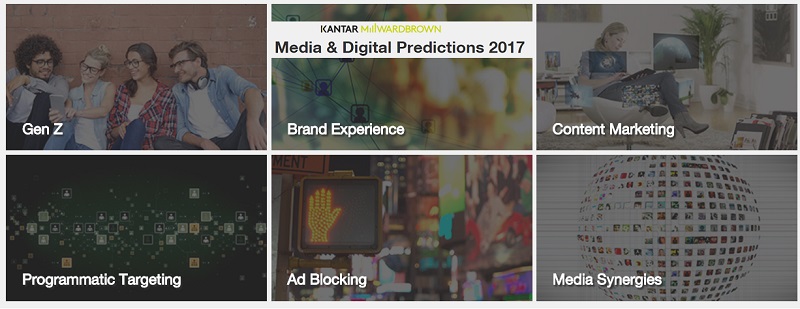The new generation of tech-savvy millennials presents a huge challenge to marketers, with high expectations and values.
Kantar Millward Brown, a leading global research agency helping businesses grow strong brands, today released its annual digital and media predictions for 2017. For the ninth-year running, the company’s predictions provide marketers with a clear guide to the challenges and opportunities of the next 12 months, helping them shape their digital marketing strategies.
Top of the marketing to do list for the year should be gaining a rapid understanding of the needs, aspirations and behaviours of Generation Z, also called post-millennials and centennials. Brands will have to create better connected consumer journeys that are less intrusive with a smarter and more measured approach that discourages ad blocking.
Marketers will also need to develop creative content that appeals to the imagination and emotions of the Gen Z consumer, if they want to be accepted by this key group, who number a staggering 2 billion people worldwide – approximately 27% of the world’s population was born between 1997 and 2011.
“Gen Z will not only change how brands communicate but also create challenges in how brands demonstrate authenticity and transparency in digital,” said Duncan Southgate, Global Brand Director, Media & Digital at Kantar Millward Brown. “Strategies that are likely to be successful include investment in digital platforms that allow consumers to co-create a shared brand experience; Gen Z will be hands on – they want to try it, take it apart and re-create it.”
Brands will have to be more open, share their story, their purpose and details of their production processes to allow Gen Z to determine if the brand’s values match their own.
Finally, marketers will have to move away from their current focus on the linear, factual and linguistic in favour of digital content that appeals to the imagination via technologies such as Augmented Reality (AR) and Virtual Reality (VR); immersive formats that allow for stronger visual imagery. Gen Z will also respond much more than Millennials to emotional, musical narratives, creating new opportunities for creativity that appeals to all of people’s senses.
Southgate added: “This will require a new approach to branded content. With the landscape ripe for new creativity, marketers will need to closely monitor which formats Gen Z and other consumers find annoying and intrusive, particularly on their first screen, mobile. Alongside this new form of content, marketers also need to deliver a seamless brand experience across all touchpoints. Gen Z have grown up in a connected world and are impatient towards disjointed online/offline models that are older than they are – and this group will not adapt.”
Making all this happen, requires a single view of the consumer and a consistent brand experience, something that will require new ideas and considerable time and investment. For many established brands, this will require years of focus on structure and data management. In 2017, the goal should be to focus on tone of voice and delivering a consistent brand experience across touchpoints that have the most impact and influence.
Kantar Millward Brown also anticipates other important changes, including:
· Balancing targeting and intrusion – In 2017, marketers will focus on finding the right balance between programmatic targeting and what consumers feel is an intrusive level of messaging. Advertisers and their agencies will use a greater mix of audience targeting data based on brand affinity, interests and the appropriate demographics. Kantar Millward Brown expects to see a shift away from simplistic blunt-instrument targeting based on a single input – be it behavior (websites visited, items in a shopping cart), demographics, or stand-alone brand affinity.
· More media synergies – Marketers will wake up to the growing significance of media synergies in 2017, and their potential to maximise brand and sales impact. CrossMedia studies conducted by Kantar Millward Brown show that synergies can drive 25% of media effectiveness globally and nearly 40% in the Asia-Pacific region. Increasingly, non-TV synergies are emerging, creating new opportunities for advertisers and agencies, to ensure the sum of the media schedule is always greater than its parts.
· Positive action to deter ad blocking – The good news for brands is that the rising tide of ad blocking could be on the turn. While advertisers and publishers will have to adopt better ad formats and proactively look to engage with consumers on the issue, the current set of ad blocking tools are demonstrating their own lack of authenticity via site performance issues/ content restrictions and the questionable ethics of attempting to make money from the ad units they authorise.
“Every year brings new challenges but the emergence of Gen Z puts the focus on a new generation of consumers who are different to their predecessors. Vast in number and mobile first, they have come of age in the wake of the global financial crisis and will make new demands of brands that want to earn a place in their lives. Understanding the nuances of Gen Z should be a priority for marketers as they work out how their communications and the tools that power them will need to adapt in the years ahead,” concluded Southgate.
To read the predictions, go to www.millwardbrown.com/predictions.
